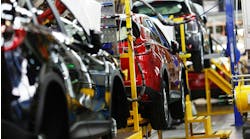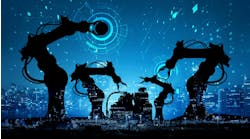Four accelerators for capturing value using the Artificial Intelligence of Things
Read Twitter, LinkedIn and any number of IoT-related websites and you’ll find a lively dialogue about the value of the internet of things (IoT). But lately, the conversation has turned to how companies can more quickly and effectively gain and exploit insights from IoT initiatives. The combination of IoT and AI provides a pathway for companies to reach this desired outcome. In fact, these two technologies complement one another and should be tightly connected.
SAS and IIC's Jane Howell
In the fast-growing world of IoT, which connects and shares data across a vast network of devices or things, organizations win with analytics. For its ability to make rapid decisions and uncover deep insights as it “learns” from massive volumes of IoT data, AI is an essential discipline within analytics for any organization that wants to expand the value of IoT.
AI and IoT (that is, the artificial intelligence of things, or AIoT) work together to create new value for organizations across a broad spectrum of industries—from manufacturers and retailers to energy, smart cities, health care and beyond.
The potential of AI and the intelligence of things
AI-powered connected smart devices and environments learn from a greater network of data sources (including each other) and contribute to collective intelligence. There are numerous examples across industries that illustrate this potential – from utilities and manufacturers who can detect underperforming assets and predict the need for maintenance or automated shutdown before costly or hazardous equipment failures occur, to remote monitoring devices that provide at-home diagnostics, alert caregivers when intervention is needed and remind patients to take their medications.
Bringing advanced analytics to the edge
Where analysis of IoT data takes place depends on issues of bandwidth and latency: For applications that can tolerate some delay or are not bandwidth intensive, such as collecting summary data of a device’s operation, the IoT device sends data to the cloud or data center, which analyzes it considering historical performance and other trends. Insights gained from the analysis can then be used to make decisions on subsequent operation of the device, including modifying the control program on the device itself. For cases where mobile or remote assets churn out lots of data that must be analyzed quickly—such as self-driving vehicles or drones—or where bandwidth is constrained, data processing is moved as close to the data source as possible—to the edge.
With AI-powered capabilities, IoT data can be transformed, analyzed, visualized and embedded across the entire ecosystem—edge devices, gateways and data centers, in the fog or in the cloud.
AIoT in action—a transportation example
Millions of trucks transport fuel, produce, electronics and other essentials across highways every day. But unplanned downtime can exact a tremendous toll on any fleet operator and their customers who depend on timely deliveries. Volvo Trucks and Mack Trucks, subsidiaries of the Swedish Manufacturer AB Volvo, have met this challenge through remote diagnostic and preventative maintenance services based on IoT technologies with advanced analytics including artificial intelligence.With these solutions, Volvo Trucks and Mack Trucks can help their customers maximize a vehicle’s time on the road and minimize the costs of service disruptions by servicing connected vehicles more efficiently, accurately and proactively.
Volvo Trucks’ Remote Diagnostics monitors data from each truck for fault codes triggered when something is amiss with a major system. Thousands of sensors on each truck collect streaming IoT data in real time to provide context around where the event happened and what conditions were present during the fault. Similarly, Mack Trucks’ GuardDog Connect helps customers evaluate the severity of issues and manage repairs by remotely collecting data from the vehicle in the form of fault codes and other parameter data, then ranking them based on severity. If a fault requires immediate action, an agent contacts the customer to explain the situation and recommended action. If it’s less time-sensitive or does not involve a potential injury, the repair is planned for when it makes the most sense for the operation.
The results of pairing sensor data and IoT technologies with advanced analytics including AI have been impressive. For Volvo Trucks, diagnostic time was reduced by 70 percent and repair time by 25 percent. Mack Trucks points to benefits for all stakeholders – dealers experience a more efficient process, and greater uptime keeps customers happy.
Four accelerators for capturing value
So, how can you realize success with AIoT?
Looking beyond the physical infrastructure of the intelligent IoT—the sensors, cameras, network infrastructure and computers—there are four keys that underpin a successful deployment:
1) Think real-time analytics
Analyze high-velocity big data while it’s still in motion—before it is stored—so you can take immediate action on what’s relevant. Seize opportunities and spot red flags hidden in torrents of fast-moving data flowing through the business. Event stream processing plays a vital role in handling IoT data, and will be even more vital with advances like 5G, to:
- Detect events of interest and trigger appropriate action. Event stream processing pinpoints complex patterns in real time, such as an action on a person’s mobile device or unusual activity detected during a banking transaction. Event stream processing offers quick detection of threats or opportunities.
- Monitor aggregated information. Event stream processing continuously monitors sensor data from equipment and devices, looking for trends, correlations or anomalies that could indicate a problem. Smart devices can take remedial action, such as notifying an operator, moving loads or shutting down a motor.
- Cleanse and validate sensor data. When sensor data is delayed, incomplete or inconsistent, several factors could be at play. Is dirty data caused by an impending sensor failure or a network disruption error? A variety of techniques embedded into data streams can detect patterns and troubleshoot data issues.
- Predict and optimize operations in real time. Advanced algorithms can continuously score streaming data to make decisions in the moment. For example, information on a train’s arrival could be analyzed in context to delay a train’s departure from another station, so commuters won’t miss their connections.
2) Deploy intelligence where the application needs it
The use cases described earlier entail data that is constantly changing and in motion (such as a driver’s geolocation or temperature inside a data center) as well as other discrete data (such as customer profiles and historical purchase data). This reality calls for analytics to be applied in very different ways for different purposes—a multi-phase approach. For example: high-performance analytics does the heavy lifting on data at rest, in the cloud or otherwise in storage. Streaming analytics analyzes large amounts of diverse data in motion, where only a few items are likely to be of interest, the data has only fleeting value, or when speed is critical, such as sending alerts about an impending collision or component failure. Edge computing enables a system to act on the data immediately, at the source, without pausing to ingest, transport or store it—a must for many uses in the sensor driven world of IoT devices and services.
3) Combine AI technologies
To realize the highest returns with AIoT, look beyond deploying a single AI technology. Take a platform approach where multiple AI capabilities work together, such as machine learning and deep learning, for natural language processing and computer vision.
For example, a research clinic of a large hospital combines several forms of AI to provide diagnostic guidance to its physicians. The clinic uses deep learning and computer vision on radiographs, CT scans and MRIs to identify nodules and other areas of concern on the human brain and liver. This detection process uses deep learning techniques such as convolutional neural networks (CNN) to analyze visual imagery.
The clinic then uses a completely different AI technology—natural-language processing—to build a patient profile based on family medical history, medications, prior illnesses and diet; it can even account for IoT data, such as pacemaker data. Combining natural language data with computer vision, the tool enables valuable medical staff to be much more efficient.
Much of the value of the AI-empowered IoT is the promise to act now. Make customers the right offer before they look away. Detect the suspicious transaction before it is approved. Help that self-driving car maneuver through the busy intersection without crashing into other moving vehicles. Do it now. Latency matters.
Clearly, many types of sensors and devices cannot wait for data or commands from the cloud. And for other uses, it just isn’t necessary. For monitoring, diagnosing and acting on individual pieces of equipment, such as home automation systems, it makes sense to do the analysis as close to the device as possible. Sending locally sourced, locally consumed data to a faraway data center causes needless network traffic, delayed decisions and drain on battery powered devices.
With the exponential increase in IoT devices and their data volumes—along with demand for low latency—we have seen a trend to move analytics from traditional data centers toward devices on the edge—the things—or to other compute resources close to edge and cloud.
4) Unify the complete analytics lifecycle
To achieve value from the connected world, the AIoT system first needs access to diverse data to sense what is important as it is happening. Next, it must distill insights from the data in rich context. Finally, it must get rapid results, whether to alert an operator, make an offer or modify a device’s operation.
Successful IoT implementations will link these supporting capabilities across the full analytics lifecycle:
- Data analysis on the fly. This is the event stream processing piece of it described earlier. Event stream processing analyzes huge volumes of data at very high rates (in the range of millions per second)—with extremely low latency (in milliseconds)—to identify events of interest.
- Real-time decision making/real-time interaction management. The streaming data about an event of interest—such as a car’s constantly changing location, direction, destination, environment and more—goes into a recommendation engine that triggers the right decision or action.
- Big data analytics. Getting intelligence from IoT devices starts with the ability to quickly ingest and process massive amounts of data—most likely in a distributed computing environment such as Hadoop. Being able to run more iterations and use all your data—not just a sample—improves model accuracy.
- Data management. IoT data may be too little, too much and certainly in multiple formats that must be integrated and reconciled. Solid data management can take IoT data from anywhere and make it clean, trusted and ready for analytics.
- Analytical model management. Model management provides essential governance across the lifecycle of analytical models, from registration to retirement. This ensures consistency in how models are managed—the means to track the evolution of models and ensure that performance does not degrade over time.
When you think IoT or think AI, the takeaway is clear:
First, if you’re deploying IoT, deploy AI with it. Secondly, if you’re deploying AI, think about the gains you can make by combining it with IoT. And finally, either one has value alone, but they offer their greatest power when combined. IoT provides the massive amount of data that AI needs for learning. AI transforms that data into meaningful, real-time insights on which IoT devices can act.
The key is to get started, if you haven’t already! If you’re in a pilot, make sure that you can actually deploy and scale the solution to meet the needs of the business. If you’re already using AIoT to meet the needs of your business, I’d love to hear about your successes!
Jane Howell is IoT solutions leader with SAS and an Industrial Internet Consortium member




